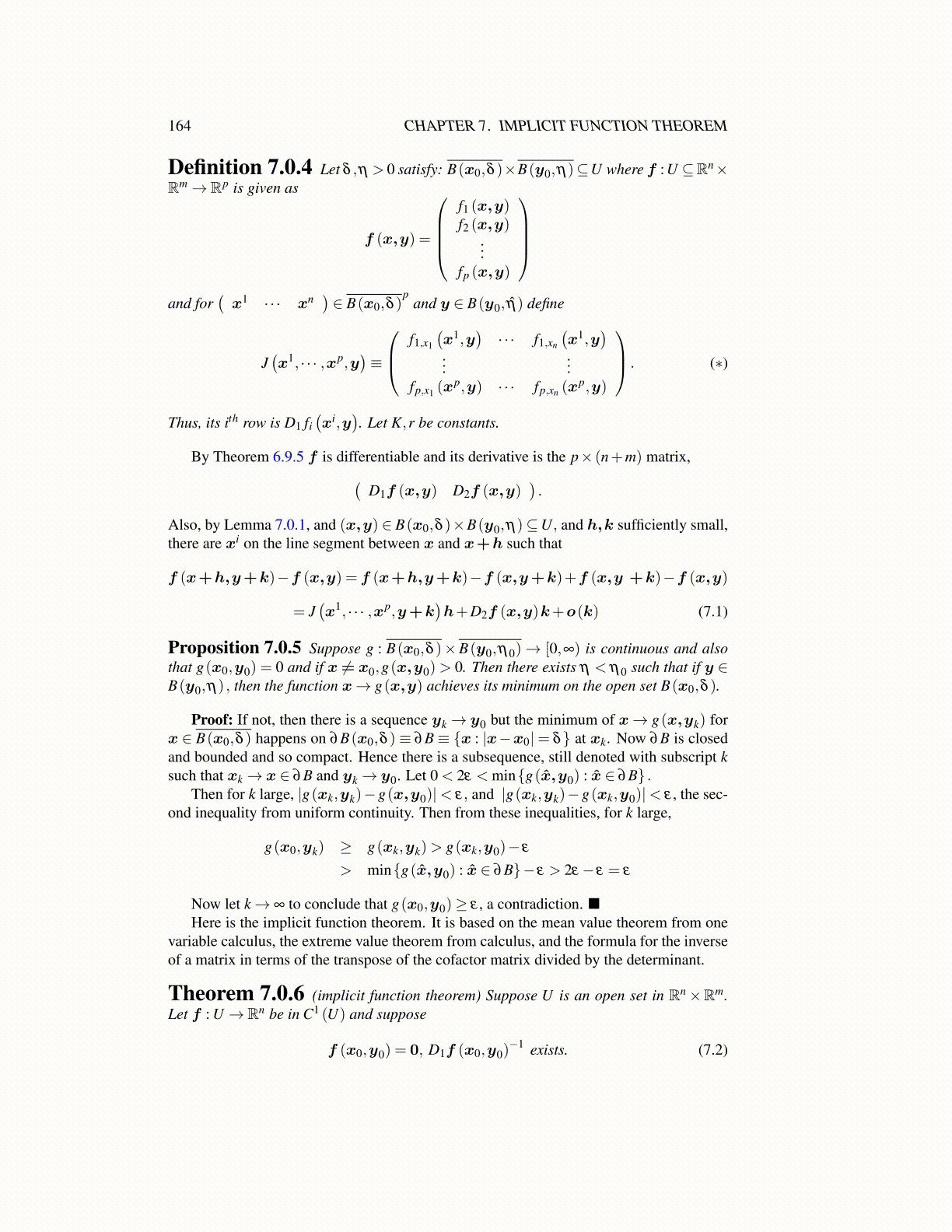
164 CHAPTER 7. IMPLICIT FUNCTION THEOREM
Definition 7.0.4 Let δ ,η > 0 satisfy: B(x0,δ )×B(y0,η)⊆U where f : U ⊆Rn×Rm→ Rp is given as
f (x,y) =
f1 (x,y)f2 (x,y)
...fp (x,y)
and for
(x1 · · · xn
)∈ B(x0,δ )
pand y ∈ B(y0, η̂) define
J(x1, · · · ,xp,y
)≡
f1,x1
(x1,y
)· · · f1,xn
(x1,y
)...
...fp,x1 (x
p,y) · · · fp,xn (xp,y)
. (∗)
Thus, its ith row is D1 fi(xi,y
). Let K,r be constants.
By Theorem 6.9.5 f is differentiable and its derivative is the p× (n+m) matrix,(D1f (x,y) D2f (x,y)
).
Also, by Lemma 7.0.1, and (x,y) ∈ B(x0,δ )×B(y0,η)⊆U, and h,k sufficiently small,there are xi on the line segment between x and x+h such that
f (x+h,y+k)−f (x,y) = f (x+h,y+k)−f (x,y+k)+f (x,y +k)−f (x,y)
= J(x1, · · · ,xp,y+k
)h+D2f (x,y)k+o(k) (7.1)
Proposition 7.0.5 Suppose g : B(x0,δ )×B(y0,η0)→ [0,∞) is continuous and alsothat g(x0,y0) = 0 and if x ̸= x0,g(x,y0)> 0. Then there exists η < η0 such that if y ∈B(y0,η) , then the function x→ g(x,y) achieves its minimum on the open set B(x0,δ ).
Proof: If not, then there is a sequence yk→ y0 but the minimum of x→ g(x,yk) forx ∈ B(x0,δ ) happens on ∂B(x0,δ ) ≡ ∂B ≡ {x : |x−x0|= δ} at xk. Now ∂B is closedand bounded and so compact. Hence there is a subsequence, still denoted with subscript ksuch that xk→ x ∈ ∂B and yk→ y0. Let 0 < 2ε < min{g(x̂,y0) : x̂ ∈ ∂B} .
Then for k large, |g(xk,yk)−g(x,y0)|< ε, and |g(xk,yk)−g(xk,y0)|< ε , the sec-ond inequality from uniform continuity. Then from these inequalities, for k large,
g(x0,yk) ≥ g(xk,yk)> g(xk,y0)− ε
> min{g(x̂,y0) : x̂ ∈ ∂B}− ε > 2ε− ε = ε
Now let k→ ∞ to conclude that g(x0,y0)≥ ε , a contradiction. ■Here is the implicit function theorem. It is based on the mean value theorem from one
variable calculus, the extreme value theorem from calculus, and the formula for the inverseof a matrix in terms of the transpose of the cofactor matrix divided by the determinant.
Theorem 7.0.6 (implicit function theorem) Suppose U is an open set in Rn×Rm.Let f : U → Rn be in C1 (U) and suppose
f (x0,y0) = 0, D1f (x0,y0)−1 exists. (7.2)